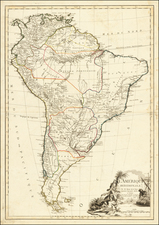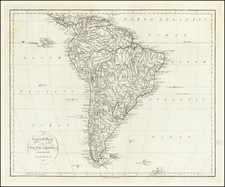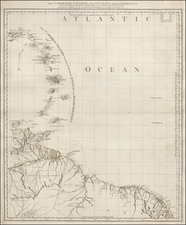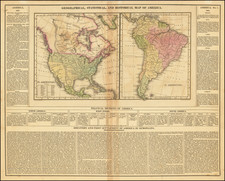The Largest City in the World South of the 46th Parallel South -- Shortly After The Tierra del Fuego Gold Rush
Interesting ephemeral map of Punta Arenas, Chile, published shortly after the conclusion of the Tierra del Fuego Gold Rush (1883-1906) and before the opening of the Panama Canal.
Oriented with east at the top, the map shows the geometrical street-plan of the city, along the shores of the Straits of Magellan, and along the banks of the Río de la Minas. Every street is labeled and each of the city's seven wards is coloured in its own distinct hue.
A key in the upper left corner identifies numerous edifices and facilities, including churches, government offices, coast guard stations, theatres, schools, banks, hotels, post offices, telegraph stations, rail lines, hospitals, firehouses and pharmacies.
The map is ringed by advertisements for local businesses, which reveal the multi-cultural nature of the city, which, over the last three decades, had benefitted from diverse waves of immigration from across Europe.
Punta Arenas, Chile, is the largest city in the World south of the 46th Parallel South. The site was named 'Sandy Point' (later Hispanicized to 'Punta Arenas) in 1765 by the British officer Commodore 'Foul Weather Jack' Byron during his Circumnavigation expedition. While its strategic location was immediately recognized, it was not until 1848 that the Chilean government founded a small fort and penal colony at the site, so as to secure Chilean sovereignty over the Straits of Magellan. Over the coming decades, the city grew beyond its convict origins and prospered as a shipping entry port, and sheep farming, fishing and mining centre.
Punta Arenas' prominence was a major factor in Chile being awarded possession of all of the Straits of Magellan in the 1881 Chile-Argentina Boundary Settlement.
Punta Arenas prospered greatly as the main Chilean outfitting centre for the Tierra del Fuego Gold Rush (1883-1906). It also became home to the world's largest sheep ranching enterprise, Sociedad Explotadora de Tierra del Fuego, which controlled over square kilometers (3,900 square miles) of pasture in southern Chile and Argentina. Punta Arenas was the favoured refueling point for steamers sailing through the Straits, one of the world's most important shipping lanes.
The economic opportunity attracted waves of immigration from Germany, England, Russia and, notably, Croatia.
The present map was evidently sponsored by the local businesses promoted in the advertisements along its margins. It was published in Punta Arenas by the 'El Magallanes' lithography firm, issued in 1912, when the city was as the height of its historic prosperity. While its role in global shipping would decline upon the opening of the Panama Canal in 1915, Punta Arenas would soon gain a new role as the most important base for expeditions to Antarctica.
Such early ephemeral maps of Punta Arenas are today very rare, as well as valuable historical artifacts of one of South America's most intriguing locales.
We acknowledge the fine work of Dr. Alex Johnson and Dr. Dasa Pahor for the above description.









![[Unusual Italian Immigrant Communities shown!] America Settentrionale, Centrale e Meridionale -- Carta Dimostrativa Delle Ambasciate, Legazioni, Consolati (Con Le Risettive Circoscrizioni Territoriali), Camere Di Commercio, Agenzie Commerciali, Stazion Enotecniche, Uffici Postali, Ospedali, Scuole Governative e Sussidiate All'Estero](https://storage.googleapis.com/raremaps/img/small/86098.jpg)




